IMPORTANT POINTS
Nervous system has evolved to maintain coordination and integration amongst different tissue,organs and system of body. So that body can work as one complete and an afficient unit. During course of evolution ,it has undergone many changes from simplest to the most complex. In all these forms neuron has remained structural and functional unit of the nervous system.Neurons are consist of cyton (cell body) and processes.They are divided into three main types:
unipolar,bipolar and multipolar.
The neuron remain freely scattered under body wall and are interconnected to make simplest and very first evolved nervous system in coelentrata (e.g Hydra), With increase in complexity and body organization (tissue,organ and organ system ). It has developed in to a better and an effective structure. like ganglion and nerves (flat worms) ganglionated with nerve cord(Arthropoda,Annelida,Mollusca) and highly complex structures like brain, spinal cord (vertbrata).
Nervous sysem of human is divided in to CNS and PNS. CNS is comprised of brain and spinal cord,
Cranial nerves,spinal nerves [somatic section] and sympathetic and para-sympathetic nervous system [autonomic nervous system] makes PNS.CNS and PNS are covered by three meninges, Dura mater, Arachnoid and Pia mater. Nervous system consist of two type of tissues white matter(medullated nerve fibre and neurons with long processes) and grey matter (non-meddullated fibres and neurons with short processes).Brain is divided in to fore brain, mid-brain and hind brain, Fore brain consist of cerebrum, diencephalon (thalamus and hypothalamas) Corpus callosum and associated area are important regions of cerebrum. Association area of brain are linked with intersensory neuron association, memory and Communication. Limbic system is present in fore brain which include amygdala and hippocampus. Limbic system and hypothalamus together regulate sexual behaviour and emotional expressions.
Mid brain consist of corpora quadrigemina,which are concerned with vision and hearing.
Hind brain consist of three region Pons,Cerebllum and medulla oblongata.
Mid brain and hind brain together form brain stem Spinal cord is second major component which controls both voluntary and involuntary functions. Reflexes are regulated mainly by spinal cord, they are spontaneous and not under the control of will.
Autonomic (Autonomous) nervous system is divided in to two major section; Sympathetic and Parasympathetic nervous system. Both are complementary to each other and helps in normalizing body functions. they regulate function of various orgaus as under.
(i) Iris (Sympathetic) – expand it.(Parasym) – contract it.
(ii) Alimentary Canal (Sympathetic) – Slow down peristalsis (Parasym) – Speed up peristalsis
(iii) Blood Pressure (Sympathetic) – Increases(Parasym) – decreases
(iv) Hair (Sympathetic) – Erect(Parasym) – Normal/ oblique
(v) Urinary bladder (Sympathetic) – Relaxation(Parasym) – Contraction.
(vi) Sweat Gland (Sympathetic) – Increases activity(Parasym) – Decreases activity
Nerves of the PNS are divided into sensory, motor and mixed 12 pairs of nerves arising from brain are called cranial nerves. Some these are sensory, some are motor and some of these are mixed nerves cranial nerver are classified on the basis of that number, name, types, orgin, target, organs and function as under.
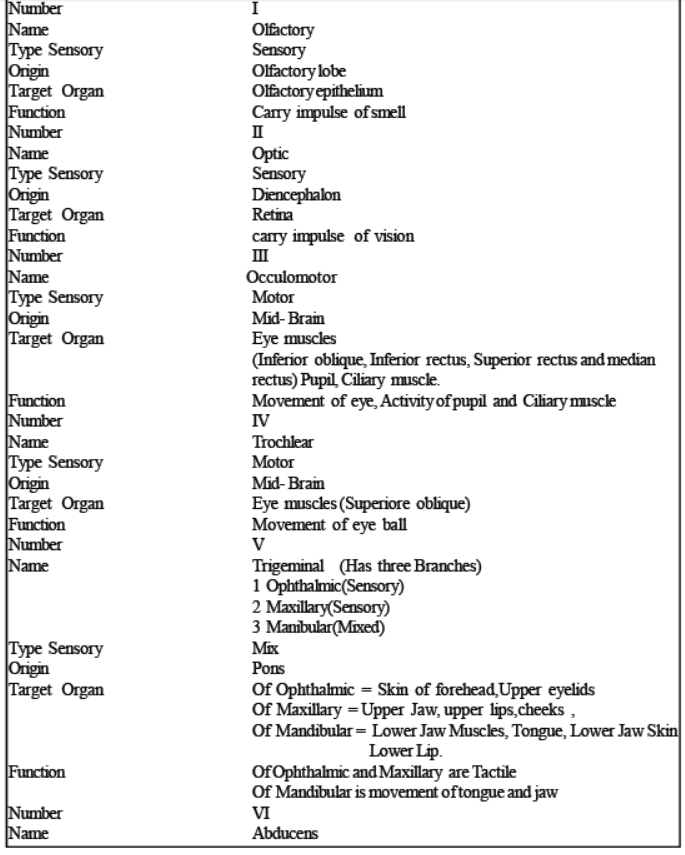
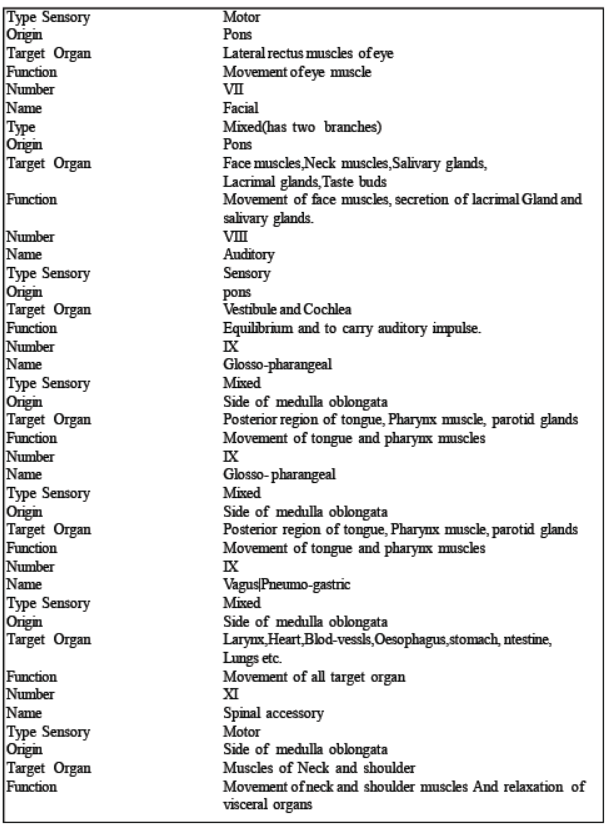
Number XII
Name Hypo-Glossal
Type Sensory Motor
Origin Side of medulla oblongata
Target Organ Tongue
Function Movement of tongue
31 pairs of spinal nerves are arising from spinal cord. All these are mxied nerves.
Sense organs enable us to receive and realize external as well as internal stimuli Sense organs are of human are of two types ; in terms of their sensory cells . some are with very specialized structure, in which the sensitive sensory cells are localized (e.g.eye, ear, tastebud, olfactory epithelium).in some special structure.
The other are general sense organs, cells of wich are not present in specialized structures, but scattered under skin or in the wall of Some organs.
In human a pair of eyes are located in deep sockets called orbit, in front side of the head human eye possess, eye-lids, eye-lashes. The structure of eye has three distinct, regions; sclera, choroid and retina.
Retina of eye possesses photo receptor cells like rod cells and cone cells , cone cells are phototopic and rod cells are scotopic in nature.
Ear is sound sensory organ and also maintain balance. In human (mamals) it has three distinct regions. External ear (outer ear); middle ear and internal ear External ear has ear pinna and auditory canal Tympanic membrane and ear-ossicles (malleus, incus and stapes) are the regions of middle ear. Internal ear has two labyrinth; Bony and membranous.
perilymph surround membranous labyrinth on its outer side, where as endolymph is present in lumen (Cavity) of membranous labyrinth. Cochlea is main auditory ogan in internal ear. The oragan of corti is present on basilar membrane of cochlear canal. It has sound sensory cells. It is main sound sensory organ.
1. Which of the following option is not correct for the region labelled as "a" in the given diagram.
(a) White and fatty compound
(b) It is Conductive
(c) Region without it called node of Ranvier
(d) It is responsible for saltatary conduction
2. Which of the given option is correct for autonomous nervous system ?
(a) In it medullary sheath is very well developed
(b) Node of Ranvier is present in it.
(c) It is part of CNS
(d) It's nerve do not travel for longer distance in body
3. What does given diagram show ? where is it found ?
(a) Unipolarneuron in spinal cord (b) Bipolar neuron ; in eye of human
(c) Unipolar neuron; In embroynic stage (d) Unipolar neuron in eye of human
4. What does a and b indicate in the given diagram ?
(a) Synaptic cleft (b) Synase between axon
(c) Synapse between axon and dendron (d) Synapse - between two dendrite
5. What dose "a" and "b" indicate in the given diagram ?
(a) a = Dendrite; b = Nissl's granules (b) a = Axon fibres ; b = Nucleus
(c) a = Axon fibres ; b = Mitochondria (d) None of the given
6. What does "b" and "c" indicate in the given diagram in question no 4?
(a) b = Synapse; c = dendrites (b) c = Synapse; c = Axon fibres
(c) b = axon c = dendrit (d) b = Synaptic bulb; c = Motor nerve
7. What is correct in context with neuron ?
(a) Nissl's granule present in it are acidic
(b) It's cytoplam is restricted to only cyton
(c) Each neuron has one axon and one dendron
(d) Cyton possesses large nucleus
8. In which animal nervous system is in the form of nerve-net ?
(a) Leucosolania (b) Liver-Fluke (c) Planaria (d) Hydra
9. In which animal neverous system consist of brain, ganglion and nerve fiber ?
(a) Tape-worm (b) Liver-Fluke (c) Ascaris (d) Allof the given
10. which option shows correctly matched pairs for the column I and Column II ?
Column-I Column-II
(P) Unipolar neron (i) Retina
(Q) Bipolar neuron (ii) Cerebral hemisphere
(R) Multipolar neuron (iii) Embroyonic stage
(a) (P-iii), (Q-i), (R-ii) (b) (P-ii), (Q-i), (R-iii)
(c) (P-iii), (Q-ii), (R-i) (d) (P-ii), (Q-iii), (R-ii)
11. What type of process the transmission of nerve impluse is ?
(a) Electromagnetic (b) Electro -chemical
(c) only Elecrical (d) only Magnetic
12. What is correct for the resting potential
(a) On innerside of plasma membrane + ve charge & outerside -ve charge is found
(b) On outerside Na+ concentrartion is less ,on innersde k + concentrtion is less
(c) On outerside a plasma membrane + ve charge and innerside is -ve charge
(d) Electrically it is neutral in resting stage.
13. That is correct for unstimulated nerve- fibre ?
(a) Resting potential (b) Action potential (c) Repolarization (d) Depolarization
14. Which option is correct for ion chhanel ?
(a) They are consist of lipid. (b) They always remain open.
(c) They are Permeable to more than one ion (d) They are consist of protein
15. Which option indicates correct chronology of the changes occuring during transmission of nerve impulse ?
(a) Nerve fibre - depolarization - action polential - repolarization - activation of Na+ and K+ pump
(b) Nerve fibre - depolarization - action polential - activation of Na+ and K+ pump - repolarization
(c) Nerve fiber - depolarization - repolarization - action polential - activation of Na+ and K+ pump
(d) Nerve fiber - Activation of Na + and K+ pump - depolarization - repolarization -
16. Which of the following is used to measure membrane potential ?
(a) Sphigmomanometer (b) Thermometer
(c) Voltmeter (d) Galvanometer
17. What is responsible for the opening and closing of ion-channel ?
(a) Electrical changes & Chemical Changes
(b) More Na+ Conc out side of plasma membrane
(c) More K+ Conc innerside of plasma membrane
(d) On both Side of membranes Na+ and K+ are in equal proportion
18. What does "a" and "b" indicate in the given diagram ?
(A) a = Synaptic bulb b = Phagocgtosis
(B) a = Presynaptic b = Phagocytosis
(C) a = Synaptic gap b = Secretion of neurotranmetter
(D) a = Presynaptic bulb b = Secretion neurotranmitter
19. What does “a” indicate in the given diagram
(a) Repolarization (b) Depolarization
(c) Resting potential (d) Activation of Na+ and K+ pump
20. In context with conduction of nerve impulse,what is the function of ion channels ?
(a) Maintenance and change in electric potential
(b) Transport of ions against diffusion gradient
(c) Transport of Na+ ion to the innerside of a the membrane
(d) All of the given
21. When sodium and potassium pump is activated, for (a) Na+ ion, (b) K+ ion are exchanged ?
(A) a = one , b= two
(B) a = two, b= four
(C) a = two , b= three
(D) a = one, b= three
22. The transfer of ion through ion channel is (a) and (b)
(a) a = Bidirectional, b= selectively permeable
(b) a =Unidirectional, b= permeable
(c) a = Bidirectional , b= semi permeable
(d) a = Unidirectional, b= selectively permeable
23. What is the swollen, structure present at terminal end of each branch of nerve cell called ?
(a) Synaptic cleft
(b) synaptic vessicle
(c) synapse
(d) synaptic knob
25. Which of the following generally transumit nerve inpulse only to the cyton ?
(a) Axon (b) Dendrite (c) Synaptic knob (d) Node of Ranvier
26. What is correct in reference with nerve impulse ?
(a) Self-induced and unidirectional
(b) Selt-induced and bidirectional
(c) Electric potential in the nerve by region increase
(d) Ion channel get closed in this region.
27. ____________ is wraped by cerebrum ?
(a) Thalamus (b) Hypothalamus
(c) Cerebellar hemisphere (d) Mid- brain

29. Which of the follwing is a thin transparent nonvasscular meninges around CNS ?
(a) Dura mater (b) Pia mater (c) Arachnoid (d) Grey matter
30. Which of the following option indicates correct chronology of the meninges from cranium to CNS ?
(a) Dura mater →Arachanoid → Pia mater (b) Pia mater → Arachanoid → Dura mater
(c) Pia mater →Dura mater → Arachanoid (d) Arachanoid →Dura mater →Pia mater
31. Which of the following option is the correct option for the inner most meninges of CNS ?
(A) very Thick and tough (B) Thin and vascularized
(C) Highly vascularized (D) Thin non vascularized
32. Which of the following is toughest ?
(A) Piamater (B) Arachnoid (C) Dura mater (D) None of the given
33. Which of the following is adherent to brain ?
(A) Arachnoid (B) Pia mater (C) Dura mater (D) None of the given
34. Which of the following does not have lumen ?
(A) cerebrum (B) cerebellar hemisphere
(D) Diencephalon (D) Medulla
35. Which of the following is not related to fore brain ?
(A) lateral ventricle (B) Inferior Collicule
(C) Corpus callosum (D) Voluntary locomotion
36. Which of the following have major co-ordinating centres for sensory and motor signal
(A) Brain stem (B) Pons (C) mid brain (D) Thalamus
37. It has centres to regulate body temperature ?
(A) Thalamus (B) Hypothalamus
(C) Corpora quadrigemina (D) Pons
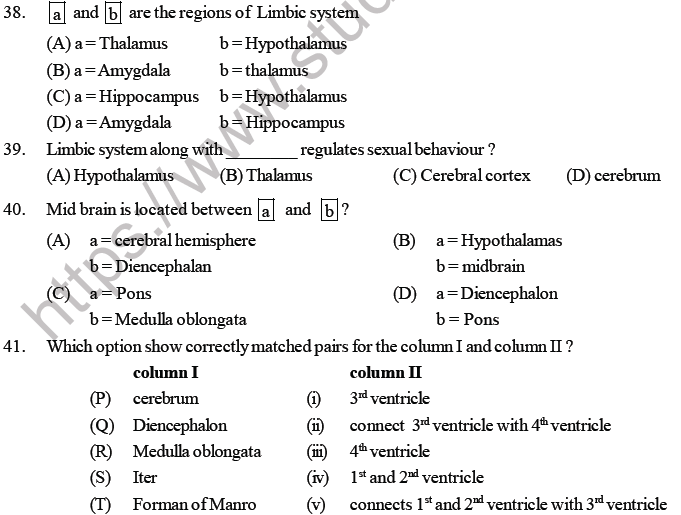
(A) (P - ii), (Q - i), (R - iv), (S - iii), (T - v) (B) (P - iii), (Q - i), (R - iv), (S - ii), (T - v)
(C) (P - iv), (Q - i), (R - iii), (S - v), (T - ii) (D) None of the given
43. On which side of the brain corpora quadrigemina is present ?
(A) Dorsal (B) Ventral (C) Lateral (D) ventro lateral
44. What is the function of superior colliculi of mid brain ?
(A) To control emotional reflex (B) To control Auditory reflex
(C) To control visual reflex (D) To control Audio visual reflex
45. What is posterior choroid pleues ?
(A) Non nervous epithelial folded roof (B) Non-nervous epithelial floor
(C) Nervous, epithelial folded roof (D) Nervous, epithelial folded floor
46 spot the odd ( in terms of type of reflex)
(A) Secretion of saliva on seeing tasty of food (B) Antiperistalsis
(C) Peristalsis (D) Heart - beat
47. Several examples of reflexes are given here, which of the given option indicates all correct examples of Conditoned reflex ?
Examples
(i) Prejudices (ii) Heart - beat (iii) Peristalsis (iv) dis-liking (v) Habits
(A) (i), (ii), (iii) (B) (i), (iii) (C) (i), (iv) and (v) (D) (i) and (iii)
48. Which layer of an eye is transperant and thin
(A) Outer sclera (B) middle - sclera (C) choroid (D) Retina
49. Which regions of eye is consist of dense connective tissue ?
(A) sclera (B) Sclera and cornea
(C) Choroid and retina (D) Retina and ciliary body
50. Which of the following option is correct for mechanism of vision
(A) Light - photosensitive cell - scotopsin - dissociate - signal to ganglion cell - transmission of signal to visual area
(B) Light - Transmission of signals of ganglion cell - photorecepative cell - transmission signals to visual area
(C) Light -Transmission of signals to visual degradation of scotopsin - photosensitive cells
(D) None of the given
51. What is the stiff edge of pinna called ?
(A) Tympanum (B) Lobule (C) Fenestra roundata (D) Helix
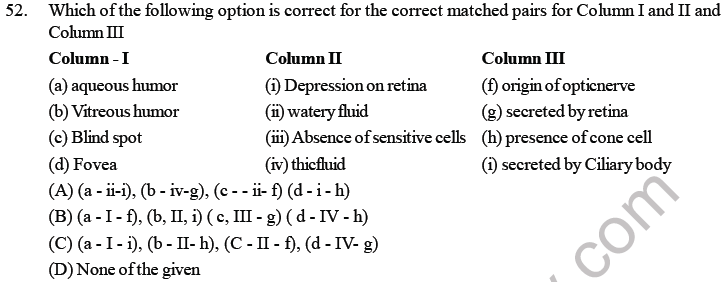
53. Peremability of which of the following increases during depolarization ?
(A) Na+ (B) K+ (C) Mg+ (D) Ag+
54. Several statements are given here in reference to cone cells which of the following option indicates
all correct statements for cone cells ?
Statements
(i) cone cells are less sensitive than Rod cells
(ii) They are responsible for colour vision
(iii) Erythrolobe is photopigment which is sensitive to red colour light
(iv) They are absent in fovea of retina
(A) (iii), (ii) and (i) (B) (ii) and (iii) (iv) (C) (iii) and (iv) (D) (i) and (ii) (iv)
55. Which of the following of are main divisions of autonomous nervous system
(A) limbic system and Hippocampus (B) Sympathetic and limbic system
(C) Sympathetic and para sympathetic (D) Brain and spinal cord
56. Which of the following option indicates correct chronology of structures of the ear (from outside is inside ) ?
(A) cochlearduct - utricule - sacule (B) Saccule - urticule - cochlearduct
(C) utricule - saccule - cochlearduct (D) Utricular - cochlearduct - saccule
57. Few statements about tympanic membrane are given here which of the following option shows all correct statement for it ?
(i) malleus bone join with it
(ii) it is oval membrane consist of unstriated muscle
(iii) It has cover of skin on its inner side and muscle layer on outerside
(iv) It has upper aperture called fenestra roundata
(A) (i) (B) (i) and (ii) (C) (ii) and (iii) (D) (i), (iv), (iii)
58. Which of the following option indicates correct chronology of middle ear ossicle (from Thympanum to interal ear)
(A) Incus - malleus - stapes (B) malleus - Incus - stapes
(C) stapes - malleus - Incus (D) malleus - stapes - Incus
59. It is correct for the function of ear ossicle
(A) To amplify sound 40 times (B) To amplify sound 20 times
(B) To amplify sound 10 times (D) To reduce harmful effect of sound
60. Which of the following is filled with perilymph ?
(A) Area around chochelar ducton outer side (B) In lumen of vestibule
(C) In semicircular canal (D) In lumen of sacculus
(A) (a - i - g), (b - ii- f), (c - i e) (B) (a - ii - f), ( b - iii - g), (c - i -e)
(C) ( a - iii - e), ( b - ii - f), (c - i - g) (D) (a - iii- f), (b - ii- e), ( c - i- g)
62. What is ciliary body ?
(A) Thick posterior part choroid (B) Thick anterior part of sclera
(C) Thick posterior part of sclera (D) Thick anterior part of choroid
63 Iris is a continuation of _______
(A) ciliarybody (B) choroid (C) Retina (D) None of the given
64. Which type of muscle are present in ciliary body ?
(A) Radial & oblique (B) Horizontal & oblique
(C) Radial and longitudanal (D) All of the given
65. What is macula lutea ?
(A) A yellow pigmented area with cone cell
(B) fovea centralis of retina, with conecells
(C) A yellow pigmented area of Choroid with rod cell
(D) Blind spot on retina
66. which basic Colour Photoreceptors are Present in human eye ?
(A) Red Yellow Orange (B) Red green blue
(C) Red green Orange (D) green yellow blue
67. Which of the folliwing has nerve centers for the urge of eating ?
(A) Pons (B) Thalamus (C) Hypothalamus (D) mid - brain
68. Deficiency abnormality of which of the following is responsible for Alzheimer's dlsease?
(A) cortisone (B) Acetyl choline (C) Adrenaline (D) nor - eninephrin
69. What is correct for the “ number ” of vagus Cranial nerve?
(A) 6 (B) 5 (C) 10 (D) 12
70. At which of the following Structure Sensitivity of retina is highest?
(A) Rod cells of Fovea centralis (B) Yellows spot
(C) Blind Spot (D) None of the given
♦ Diagram for question number 71 to 75.
71. What does “ a ” indicate in the given diagram?
(A)Cerbral hemispere (B) Optic Chiasmata
(C) Olfactory blub (D) Pineal gland
72. Which option is Correct for the of region labellel as “ b ”
(A) medulla oblongata - Hind brain - Involuntary Function
(B) Occipital lobe - Hind brain - Audio - Vlsual Centres
(C) medulla oblongata - Hind brain - Site of intellingence
(D) Pons Varolli -Mid brain - Axonal Fibre
73 What does “ c ” indicate in the given diagram?
(A) Cerebellum (B) Occipital Lobe (C) Cerebrum (D) Parietal Lobe
74. Which option is correct for the region labelled as “ d ”?
(A) Corpus callosum - Consist of large number of non - myelinated nerve fibre
(B) Cerebral Cortex - With white mater
(C) Cerebellar hemisphere - with white mater
(D) Corpus Callosum - Consist of large number of myelinated Fibre
75. What is the fuction of region labelled as “ e ”?
(A) Secrecte growth hormone (B) Secrecte melatonin
(C) Releases nutrient for the brain (D) Carry impulse of Vision
♦ Diagram for question number 76 to 79
76. What does “ a ” indicate on the given diagram.
(A) Mid brain (B) Third Ventricle (C) Lateral Ventricle (D) crebaral aqueduct
77. What does “ b ” indicate in the given diagram?
(A) - Iter (B) Lateral Ventricle (C) Central Canal (D) 4th Ventricle
78. Which option is Correct for the region labelled as “ c ”?
(A) Central Canal (B) 3rd Ventrile (C) Medulla Oblongala (D) Spinal Cord
79. What does “ e ” and “ f ” indicates in the given diagram?
(A) e = Third Ventricle (B) e = Spinal Cord
f = DienCephalon f = Central Canal
(C) e = Diencephalon (D) e = Third Ventricle
f = fourth ventricle f = medulla Oblongata
♦ Diagram for question number 80 to 82
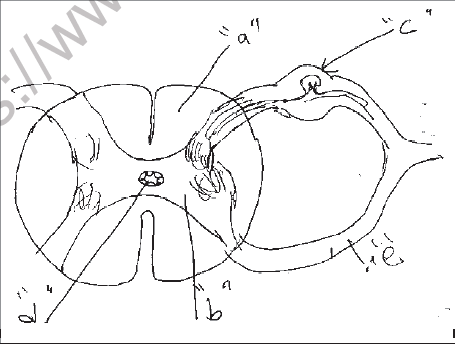
80. Which of the following option is correct for the region labellal as “ a ” a and b ?
(A) a = origin of Sensory nerve (B) a = Origin of motor nerve
b = Origin of motor nerve b = Origin of Sensory nerve
(C) a = White matter b = gray matter (D) a = Grey matter b= white matter
81. Identify the region labelleld as “ C ” and which of the following option is correct for the Significance of it?
(A) Ventral root ganglion = only of the unipolar nerve are present
(B) Dorsal root ganglion = only dendrites of the unipolar nerve are present
(C) Ventral root ganglion = Cyton of bipolar neuron are present
(D) Dorsal root ganglion; it has unipolar ncurons Cell body
82. What does “ d ” and “e ” represent in the given diagram?
(A) d = Sensoy cells, e = Central canal (B) d = Fourth ventricle, e = motor neuron
(C) d = Motor neuron, e = Central canal (D) c = Central canal d = motor nerv
♦ Diagram for question number 83 to 86
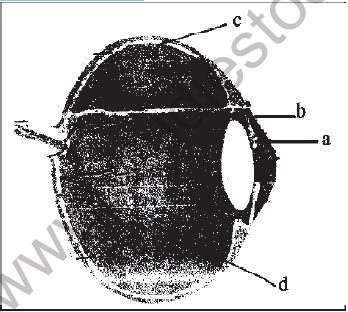
83. What is the function of region Labelled as “ a ” in the given diagaram?
(A) dispersion of the light rays
(B) Stop entry of u - v rays of light
(C) Allow only red, green and yellow colour of enter in an eye
(D) Regulate light rays entering in eye
84. what does “ b ” indicate in the given diagram?
(A) Anterior chamber ↔ aqueous fluid (B) Posterior chamber ↔ thick fluid
(C) Anterior chamber ↔ thick fluid (D) Posterior chamber ↔ aqueous fluid
85. What does “ c ” indicate in the given diagram?
(A) Sclera (B) Retina (C) Choroid (D) Yellow Spot
86. What does “ d ” indicate in the given diagaram?
(A) Anterior chamber - aqueous fluid (B) Posterior chamber - Thick fluid
(C) Anterior chamber - Thick fluid (D) posterior chamber - aqueous fluid
♦ Diagram for question number 87 to 89
87. What does “ a ” indicate in the given diagram?
(A) Cone cell - Colour Vision (B) Cone cell - Intensity of light
(C) Rod cell - Colour Vision (D) Rod cell - Intensity of light
88. What does “ b” Indicate in the given diagram
(A) Unipolar neurons of choroid (B) Bipolar neurons of retina
(C) Bipolar neurons of sclera (D) Unipolar cell of retina
89. What “ C ” indicate in hte given diagram ?
(A) Rod cell of sclera (B) Rodcells of chorold
(C) Rod cell of retina (D) cone cell of sclera
♦ Diagram for questiom number 90 to 94
90. What does region labelled as “ a “ in the diagram indicate
(A) Tympanum (B) Round window
(C) Oval window (D) external auditory canal
91. What does “ b “ indicate in to the given diagram ?
(A) Incus (B) Malleus (C) stapes (C) Window
92. What does “ d “ given diagram ?
(A) Malleus (B) Incus (C) Round window (D) stape
93. Which option is correct for the region labelled as c ?
(A) Malleus (B) Stapes (C) Round window (D) Incus
94. Which tissue is present on the innerside of the region labellow as “ a “ in the given diagram ?
(A) Muscle (B) Skeletal (C) Areolar connective (D) cartilage
♦ Diagram for questioin number 95 , 96 , 97
95. Which option is correct for the structure and function of region labelled as “ a “
(A) Sacule (B) Utricle (C) Ampulla (D) Chochear canal
96. Which is correct for the struture and function of region labelled as “ b “?
(A) Ampulla , equilibrium related (B) Semicircular canal equilibrium related
(C) chochlear canal sensitive to equilibrium (D) Ampulla Auditory centres
97 What does region labelled as “C” indicate ?
(A) ampulla (B) round Window (C) oval window (D) malleus bone
♦ Diagram for question number 98 to 102
98. What does “a” indicate in the given diagram ?
(A) Tectorial membrane (B) Innerhair cell (C) Basiliar membrane (D) Border cell
99. What does “b” indicate in the given diagram ?
(A) Basilar membrane (B) Hair cell (C) Bordercell (D) scala media
100. What does “ d “ indicate in the given diagram ?
(A) tectorial membrane (B) Outer hair cell (C) Border cell (D) Inner hair cell
101. What does “ e “ indicate in the given diagram ?
(A) Border hair cell (B) Inner hair cell (C) Inner phalangeal cells(D) Border cell
102. What does “ c “ indicate in the given diagram ?
(A) Basilar membrane (B) Pillar cell (C) Border cells (D) Scala media
♦ Diagram for question number 103 to 105
103. What does “ a “ represent in the given diagram
(A) Palatine bone (B) Eusthachian tube (C) Temporal bone (D) Tympanic membrane
104. Which option is correct for the function and location of region labelled as “ b “ in the given diagram ?
(A) To equlize pressure on either side of eardrum between middle ear and pharynx
(B) to equlize pressure on either side of eardrum between middle ear and oesophagus
(C) to distribute sound wave evenly betwen tympanum and middle ear
(D) None of the given
105. What does region labelle as “ c” indicate ?
(A) Vestibular nerve (B) Auditory nerve (C) cochlear artery (D) cochlear nerve
106. What does “ a” , “b” and “c” indicate in the given diagram ?
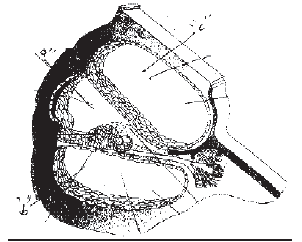
(A) a = scala media (B) a = scala tympani
b = scala Tympani b = scala media
c = scala vestibuli c = scala vestibili
(C) a = scale media (D) None of the given
b = scale vestibuli
c = scale tympanti
107. Which of the following option is correct for the statement X, Y, and Z ?
X- cerebral cortex is called association area
Y - It contains sensory area motor area and large region that neither clearly sensory nor motor in function
Z - This region is responsible for inter sensory association memory and comunication
(A) x, y and z are correct and y and z are correct for x
(B) x, y and z are correct and y and z are not correct for x
(C) x is correct and y and z are correct.
(D) x and y are correct and z is wrong.
Few statements are given in question number for the given statement X and statement Y
option for question number 180 to 120
(A) A and R both are correct and R is the correct explanation for A.
(B) A and R both are correct and R is not correct explanation for A
(C) A is correct and R is wrong
(D) R is correct & A is wrong
108. Statement A : medulla is absent in nerves of automous nervous system
Statement R : Nerve impulse has to travel less distance in autonomous nervous system
109. Statement A : Immediately after repolarization, lonic imbualance is created on sides of nerve fibre
Statement R : During repolarization K ion channel open up and K ion moves on innerside of plasma membrane
110. Statement A : Injury to interior Colliculi can impair hearing
Statement R : centre to control auditory sense are lying in it
111. Statement A :Injury to medulla can lead to the death of an individual
Statement R : It has centres to regulated major involuntary function of body
112. Statement A : coachlea can be called true organ of hearing
Statement R : Organ of corti as present in it
113. Statement A : The movement (vibration) of basilar membrane is necessary for hearing
Statement R : movement of basilar membrane separates sensory hair from tectorial membrane
114. Statement A : Rod cells possesses visual purple pigments
Statement R : They are sensitive to purple pigment colour light
115. Statement A :Amygdala are present in superficial region of cerebral hemisphere
Statement R : They makes part of limbic system
116. Statement A : synapse are of two types
Statement R : in electricrical synapses pre and post synaptic membrane are in close proximty
117. Statement A : neurotransmitters are present in synaptic vesicles present in axon terminals
Statement R : On arrived of action potential neurotransmitter unites with receptors present on pre synaptic membrane
118. Statement A : corpus callasum join two cerebral hemispheres
Statement R : corpus callosum is formed of unipolar neurons
119. Statement A : optic nerve leave eye ball at little lower and posterior pole of the eye ball
Statement R : Photosensitive cells are not present at this place
120. Statement A : Na+ and K+ pumps are activated after repolarization
Statment R : By them lonic imbalance created due to repolarization is removed
121. Given below is a table comparing the effects of sympathetic and parasympathetic nervous system for four feature (1-4) which one feature is correctly decribed?

122. Cranial nerves supplying eyes muscles are:
(A) 4,5,6 (B) 3,4,5 (C) 4,6,7 (D) 3,4,6
123. A cranial nerve with maximum branches in the body is
(A) Auditory (B) Trigeminal (C) Vagus (D) Facial
124. Bowman's glands are located in
(A) Olfactory epithelium of human nose (B) Female reproductive system of cockroch
(C) Anterior pituitary (D) Proximal end of uriniferous tubules
125. Which of the following disorder is not hereditary
(A) sickle cell anaemia (B) haemophilia (C) colour blindness (D) cataract
126. Glands responsible for secreting tears are:
(A) glands of moll (B) lacrimal glands (C) meibomian glands (D) glands of zeis
127. Which of the following cranial nerves are mixed:
1. glossopharyngeal 2. trigeminal 3. vagus 4. auditory
(A) 1,2 and 3 are correct (B)1 and 3 are correct
(C) 1 and 2 are correct (D) 2 and 4 are correct
128. To What the resparatory centres of brain are sensitive?
(A) High CO2 Conc in blood (B) Blood suppliy to brain
(C) High O2 Conc in blood (D) More blood supply to lungs
129. Nasal epithelium is formed of :
(A) columnar epithelium (B) keratinised epithelium
(C) pseudostratified epithelium (D) glandular epithelium
130. Space between piamater and arachnoid is
(A) subdural (B) supra archnoid(C) eqidural (D) subarachnoid
131. Which one is mixed nerve
(A) oculomotor (B) trochler (C) hypoglossal (D) glossopharyngeal
132. Visual area is localised in
(A) occipital lobe (B) parietal lobe (C) frontal lobe (D) temporal lobe
133. In hypothalamus are located various centres of
(A) circulation (B) sleep (C) memory (D) body tempreature
134. Which option is correct for the few statements are given for the function of cerebram, which of few following option is shows all correct statements.
(i) to control the sensitivity,movement,memory,vocabulary etc. through the frontal lobe
(ii) to control the vision and adaptation through the occipital and frontallobes
(iii) to control the contraction of voluntary muscles through the frontal lobe
(iv) to control the temperature,taste,touch,pain etc, through the parietal lobe
(A) (i),(ii),(iii) (B) (iii),(iv),(i) (C) (i),(iii),(iv) (D) (i),(ii)
135. column I lists the part of the human brain and column II lists the functions. Match the two column and identify the correct choice from those given.
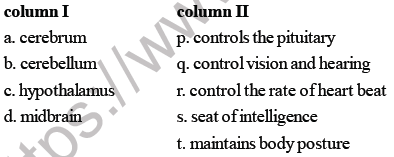
(A) (a=s);(b=t);(c=p);(d=q) (B) (a=t);(b=s);(c=r);(d=q)
(C) (a=t);(b=r);(c=p);(d=q) (D) (a=t);(b=s);(c=q);(d=p)
136. It control auditory reflex
(A) pons (B) inferior colliculi (C) pineal body (D) superior colliculi
137. In the resting state of the neural membrane,diffusion due to concentration gradients,if allowed would drive:
(A) Na+ out of the cell (B) k+ into the cell
(C) Na+ into the cell (D) k+ and Na+ out of the cell
138. Injury vagus nerve in humams is not likely to affect:
(A) gastrointestinal movements (B) cardiac movement
(C) tongue movement (D) pancreatic movememt
139. undirectional transmission of a nerve impulse through nerve fibre is due to the fact that:
(A) sodium pump starts operating only at the cyton and then continues into the nerve fiber
(B) nerve fiber is insulated by a medullary sheath
(C) neurotransmitters are released by the axon endings
(D) neurotransmitters are released by dendrites
140. Which of the following is not strictly considered a part of neuron?
(A) dendrites (B) myelin sheath (C) axon (D) Nissle's bodies
141. Centres for sense of smell are located
(A) cerebellum (B) midbrain (C) olfactory lobes (D) cerebrum
142. Nerve related to diaphragm is
(A) trigeminal (B) vagus (C) glossopharyngeal (D) phrenic
143. Node of ranvier is the place where
(A) myelin sheath and neurilemma are discontinuous
(B) axolemma is absent
(C) axolemma is discontinuous
(D) myelin sheath is discontinuous
144. Which of the following cranial nerve controls the movement of eye boll ?
(A) trocheclar (B) oculomotor (C)abducen (D)all of the given
145. Match the following human spinal nerves in column I with their respective number in column II and choose the correct option
(A) (P-iv),(Q-iii),(R-i),(S-ii) (B) (P-iii), (Q-i), (R-ii), (S-iv)
(C) (P-iv),(Q-i),(R-ii),(S-iii) (D) (P-ii), (Q-iv), (R-i), (S-iii)
146. How many pairs of spinal nerve are found in human?
(A) 33 (B) 32 (C) 31 (D) 30
147. What is Nissl's granule consist of ?
(A) DNA (B) RNA (C) protein (D) lipid
148. Which of the following is correct for motor nerve?
(A) trochelar (B) hypoglossal (C) oculomotor (D) All the given
149. Four healthy people in their twenties got involved in injuries resulting in damage and death of a few cells of the following . Which of the cells are least likely to be replaced by new cells ?
(A) liver cells (B) osteocytes (C) neurons (D) malpighian layer of the skin
150. One of the examples of the action of the autonomous nervous system is :
(A) peristalsis of the intestines (B) knee-jerk response
(C) swallowing of food (D) pupillary reflex
151. Mouth becomes watery when we look at a delocious food due to
(A) optic response(B) olfactory response (C) Hormonal response (D) neural response
152. Which of the following cranial nerve is not a motor nerve.
(A) XII (B) IV (C) II (D) III
ANSWERS

